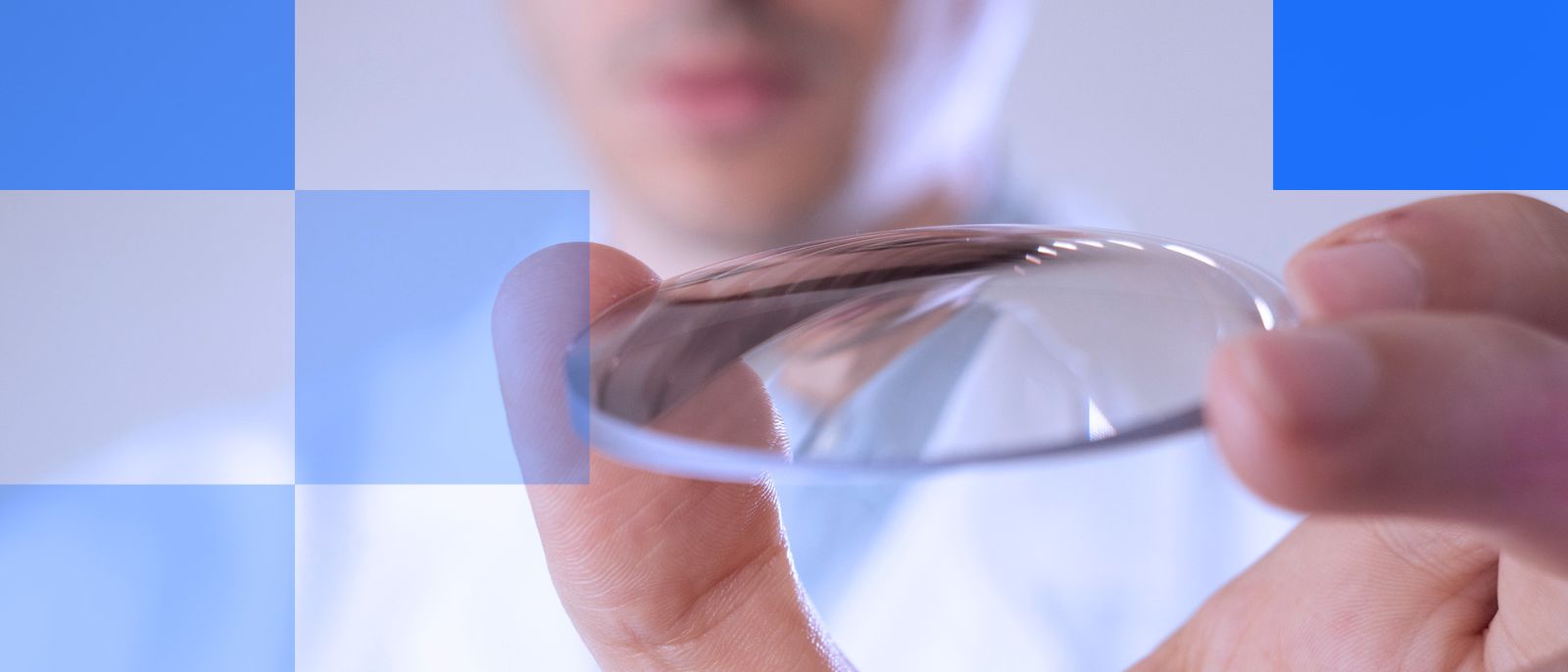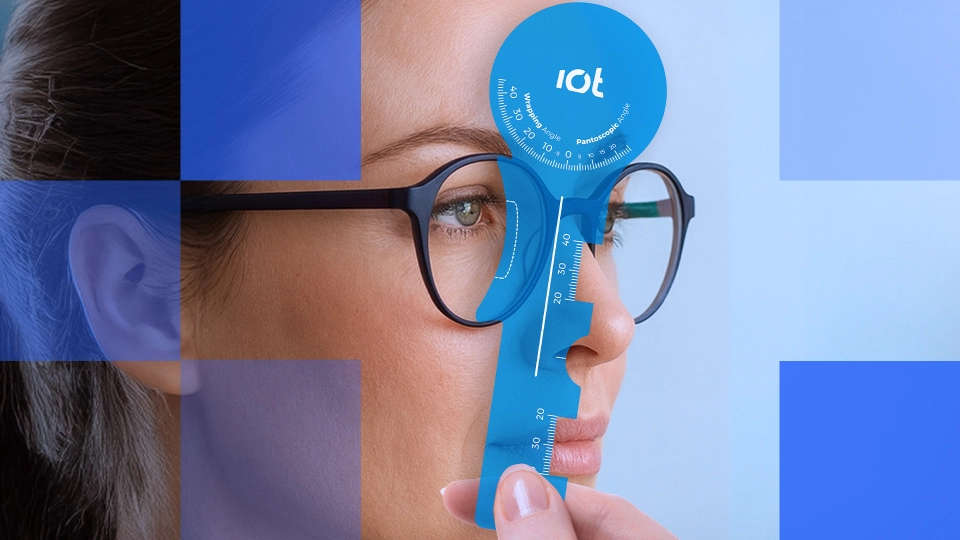
Resolviendo Problemas con Lentes Progresivas
Una guía completa para ayudar a los pacientes que no se adaptan a sus nuevas lentes progresivas
- Cuatro Pasos para Resolver Problemas
- 1. Tener un plan
- 2. Analizar los datos
- 3. Explicar
- 4. Buscar asesoría
- General Progressive Lens Troubleshooting Tips
- "I can see clearly through one pair but not the other"
- "A near vision issue solved by adding pantoscopic tilt"
- “If I do *this* I can see clearly, but if I do *this* it’s worse"
- “My last pair were fine, these are awful”
- IOT Progressive Troubleshooting Guide
- Essential Kit for Troubleshooting

Resolviendo Problemas con Lentes Progresivas
Una guía completa para ayudar a los pacientes que no se adaptan a sus nuevas lentes progresivas
Seleccionar las lentes progresivas ideales para nuestros pacientes a menudo implica conectar la óptica teórica con experiencias visuales reales. Esta guía describe pasos prácticos para los ópticos con el fin de mejorar la satisfacción del paciente y abordar eficazmente los desafíos comunes de ajuste.
Cuatro Pasos para Resolver Problemas
Abordar los problemas de adaptación de los pacientes con lentes progresivas requiere un enfoque sistemático. Ya sea para descubrir la causa raíz del malestar o para prevenir posibles inconvenientes, las siguientes estrategias pueden ayudar a garantizar un ajuste personalizado para cada individuo.

1. Tener un plan
Use una fórmula paso a paso para guiarse y registre toda la información. Siempre he encontrado útil usar una estructura de dos columnas donde pueda añadir datos del par antiguo frente al nuevo. Al compararlos lado a lado, es fácil identificar las diferencias clave. Revise:
- Prescripción (incluya una fila separada para la adición, o mejor, escriba toda la prescripción de cerca).
- Parámetros de ajuste (OC, alturas, BVD, panto, envolvimiento).
- Diseño.
- Longitud de progresión.
- Prismado para adelgazar.
- Material.
- Tratamientos.
No se preocupe por la curva base.
2. Analizar los datos
Una vez que tenga todos los datos, analice cada área: ¿qué ha cambiado y cuánto? Comience con la prescripción, luego las mediciones, seguido por el diseño de la lente, etc. Un sistema de semáforo puede ser útil para resaltar el nivel de cambio.
3. Explicar
Brinde una breve explicación al paciente sobre lo que está haciendo en cada paso. Una inquietud puede convertirse en una queja. Ofrezca al paciente un poco de conocimiento adicional y destaque su habilidad como profesional. La frase "nadie me había explicado eso antes" es (en mi opinión) un problema real en la óptica.
4. Buscar asesoría
¿Atascado? La primera persona a la que debe llamar es a su laboratorio. Ellos han procesado miles, cientos de miles de pedidos a lo largo de los años: tienen un conocimiento profundo que no podemos imaginar. Confíe en su experiencia. Envíeles su análisis, y ellos le darán la solución.
Download our PAL Troubleshooting Kit
General Progressive Lens Troubleshooting Tips
Not all visual problems can be predicted before a patient tries their new pair of spectacles. Inadaptations or discomfort may occur even after you asked the right questions and took meticulous measurements – because vision is subjective, not everything can be anticipated in just one visit.
Here are some common reasons for return visits involving progressive lenses, and a few tips on how to provide the best care and solve your patient’s issues:
"I can see clearly through one pair but not the other"
Two identical designs, two identical prescriptions, two different frames.
Backtrack to the dispense – did you advise them there could be a difference in quality of vision and size of clear area in a larger versus a smaller frame? It only takes a few mm’s.
"A near vision issue solved by adding pantoscopic tilt"
Be wary. Adding tilt induces changes to the prescription, you could solve one problem and create another.
“If I do *this* I can see clearly, but if I do *this* it’s worse"
Good old position of wear – again, changes to pantoscopic angle or wrap induce prescription changes; listen carefully to the patient. Make a quick adjustment to the angles and see if it improves things. I’m afraid a remake is probably the best thing for the patient, but at least you’ll know it’s a final remake.
“My last pair were fine, these are awful”
A multitude of reasons for this, but where it’s the same design and an increase in Rx it’s usually related to progression length. If you repeat dispense a design with a change of prescription the design changes, sometimes dramatically. You can mitigate this by choosing an appropriate progression length.
Every progressive lens wearer, new or existing should be treated like a new contact lens fit patient at every visit. Look at the menu of lenses you have, look at the different configurations: ask the questions and you’ll find the answer.
With regards to progression length, that’s an article in itself, whether it’s a first time or experienced wearer, progression length should always be a key consideration. Never underestimate the impact of repeat dispensing the same design and progression length where there are changes to the prescription or POW parameters.
IOT Progressive Troubleshooting Guide
Addressing common issues with progressive lenses involves a systematic approach. Here's a straightforward guide to help you identify and solve typical problems:
ISSUE |
POSSIBLE CAUSES | REMEDIES |
|---|---|---|
Tilting head too far up to read |
|
|
Tilting Head Up to See the Distance |
|
|
Looking to the Side to Focus Better |
|
|
Tilting Head Forward to See Distance |
|
|
Tilting Head Forward to Read |
|
|
Near Vision is Blurry |
|
|
Swimming Sensation |
|
|
Reading Area is Too Small |
|
|
Essential Kit for Troubleshooting
Uncovering root causes requires both the right tools and the right approach. Aside from rulers/digital measuring devices every dispensing optician should have a set of flippers, a marker pen and a mirror. For near vision concerns, mark up the lens (fitting cross and NVP), get the patient to hold the reading chart on top of the mirror at their preferred reading distance, stand behind them and as they remove the chart look in the mirror to see if they are looking through the NVP. Credit to Sally Bates for teaching me this many, many years ago - it's a technique I use regularly.
And my final tip…
Don’t pay attention to isocylinder maps.
We use at least 6 different charts to assess designs, and the isocylinder map plays a minor role. Any single chart is meaningless in isolation.
We'd love to know if this has helped, or if you would like more information!
*A tiny proportion of people are genuinely sensitive to base curve changes. When calculating a design, the software will work out which is the optimum base curve for the data provided – the more data given, the more accurate this will be (use accurate POW whenever possible). This is done to reduce aberrations, optimum base curve = better vision.
You might also like:






